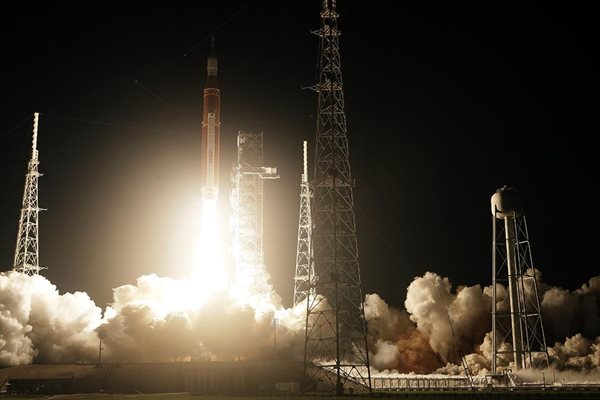NASA’s new moon rocket blasted off on its debut flight with three test dummies aboard Wednesday, bringing the U.S. a big step closer to putting astronauts back on the lunar surface for the first time since the end of the Apollo program 50 years ago.
If all goes well during the three-week, make-or-break shakedown flight, the crew capsule will be propelled into a wide orbit around the moon and then return to Earth with a Pacific splashdown in December.
After years of delays and billions in cost overruns, the Space Launch System rocket thundered skyward, rising from Kennedy Space Center on 8.8 million pounds of thrust and hitting 100 mph within seconds. The Orion capsule was perched on top and, less than two hours into the flight, busted out of Earth’s orbit toward the moon.
“It was pretty overwhelming,” said NASA Administrator Bill Nelson. ”We’re going out to explore the heavens, and this is the next step.”
The moonshot follows nearly three months of vexing fuel leaks that kept the rocket bouncing between its hangar and the pad. Forced back indoors by Hurricane Ian at the end of September, the rocket stood its ground outside as Nicole swept through last week with gusts of more than 80 mph. Although the wind caused some damage, managers gave the green light for the launch.
An estimated 15,000 people jammed the launch site, with thousands more lining the beaches and roads outside the gates, to witness NASA’s long-awaited sequel to Project Apollo, when 12 astronauts walked on the moon from 1969 and 1972. Crowds also gathered outside NASA centers in Houston and Huntsville, Alabama, to watch the spectacle on giant screens.
The 322-foot (98-meter) SLS is the most powerful rocket ever built by NASA, with more thrust than either the space shuttle or the mighty Saturn V that carried men to the moon.
A series of hydrogen fuel leaks plagued the summertime launch attempts as well as countdown tests. A fresh leak erupted at a new location during Tuesday night’s fueling, but an emergency team managed to tighten the faulty valve on the pad. Then a U.S. Space Force radar station went down, resulting in another scramble, this time to replace an ethernet switch.
NASA's new moon rocket lifts off from Kennedy Space Center's Launch Pad 39-B Wednesday, Nov. 16, 2022, in Cape Canaveral, Fla. (AP Photo/John Raoux)
Advertisement
NASA's mightiest moon rocket finally lifts off for unmanned flight
Advertisement
Latest State & National
State & National
6 hours ago
State & National
9 hours ago
State & National
12 hours ago
State & National
yesterday
State & National
yesterday
ADVERTISEMENT
Most Read >
ADVERTISEMENT
Latest State & National
State & National
6 hours ago
State & National
9 hours ago
State & National
12 hours ago
State & National
yesterday
State & National
yesterday
Advertisement
ADVERTISEMENT





